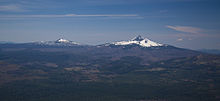Mount Washington (Oregon)
| Mount Washington | ||
|---|---|---|
| height | 2376 m | |
| location | Oregon ( USA ) | |
| Mountains | Cascade chain | |
| Coordinates | 44 ° 19 ′ 56 ″ N , 121 ° 50 ′ 19 ″ W | |
|
|
||
| Type | Shield volcano | |
| Age of the rock | approx. 250,000 years | |
| Last eruption | circa 670 AD | |
The Mount Washington is a 2376 m high mountain in the US state of Oregon . It is a heavily eroded shield volcano , which is a prominent landmark in the area between the Three Sisters in the south and Mount Jefferson in the north in the central part of the Cascade Mountains .
location
Mount Washington rises about 14 miles west of the city of Sisters , on the border between Deschutes and Linn Counties in the US state of Oregon . The area around the mountain belongs to the Deschutes National Forest, with the area immediately around the mountain being protected as the Mount Washington Wilderness as a wilderness area .
The mountain rises on the main ridge of the Cascade Range. The Three Sisters are just under 20 km south , while Mount Jefferson, Oregon's second highest peak, rises 38 km north .
Direct neighboring volcanoes in the north are the Three Fingered Jack , which is slightly higher than Mount Washington and has a very similar history of formation, and in the south the Belknap Crater , a much younger (post-glacial) shield volcano whose lava flows cover a large area.
The lower areas of the mountain are forested, while the central part of the mountain, the volcano's chimney exposed by erosion, is devoid of vegetation.
North of the mountain, US Highway 20 runs over the Santiam Pass , while the McKenzie Pass is south of Belknap Crater .
geology

Mount Washington is a shield volcano that was formed around 250,000 years ago. Some much younger (post-glacial) cinder cones on the northeast flank point to volcanic activity up to the first millennium of our era.
During the cold ages, the main ridge of the cascade was heavily glaciated, and a large part of the mountain was eroded by glacial erosion, exposing the mountain's chimney, which was made of hard effluent rock .
In the central cascades there are a number of other peaks with very similar origins and a correspondingly similar appearance, such as the northern neighbor Three-Fingered Jack or Mount Thielsen further south.
The Belknap Crater , located immediately south of Mount Washington, however, was only formed after the last periods of glaciation and gives an impression of what the (albeit larger overall) Mount Washington might have looked like.
Individual evidence
- ^ A b Raymond R. Hatton: Oregon's Sisters Country. Geographical Books, Bend, 1996. ISBN 0-89288-260-3


